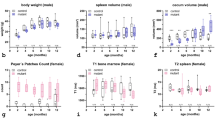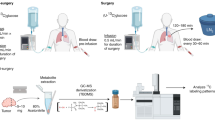Abstract
The objective of this study was first to determine whether three slowly growing early-generation murine transplantable tumours, the T40 fibrosarcoma, T115 mammary carcinoma and T237 lung carcinoma, exhibit patterns of energetics and blood flow during growth that are different from those of the faster growing RIF-1 fibrosarcoma. Serial measurements were made with 31P-magnetic resonance spectroscopy (MRS), relating to nutritive blood flow and 2H-magnetic resonance imaging (MRI), which is sensitive to both nutritive and large-vessel (non-nutritive) flow. All four tumour lines showed a decrease in betaNTP/Pi and pH with growth; however, each line showed a different pattern of blood flow that did not correlate with the decrease in energetics. Qualitative histological analysis strongly correlated with the 2H-MRI. Second, their response to 5 mg kg(-1) hydralazine i.v. was monitored by 31P-MRS. A marked decrease in betaNTP/Pi and pH was observed in both the RIF-1 fibrosarcoma and the third-generation T115 mammary carcinoma after hydralazine challenge. In contrast, the fourth generation T40 fibrosarcoma and T237 lung carcinoma showed no change in 31P-MRS parameters. However, a fifth-generation T237 cohort, which grew approximately three times faster than fourth-generation T237 cohorts, exhibited a significant deterioration in betaNTP/Pi and pH in response to hydralazine. These data are consistent with a decoupling between large-vessel and nutritive blood flow and indicate that early-generation transplants that have a slow growth rate and vascular tone are more appropriate models of human tumour vasculature than more rapidly growing, repeatedly transplanted tumours.
This is a preview of subscription content, access via your institution
Access options
Subscribe to this journal
Receive 24 print issues and online access
$259.00 per year
only $10.79 per issue
Buy this article
- Purchase on Springer Link
- Instant access to full article PDF
Prices may be subject to local taxes which are calculated during checkout
Similar content being viewed by others
Author information
Authors and Affiliations
Rights and permissions
About this article
Cite this article
Robinson, S., van den Boogaart, A., Maxwell, R. et al. 31P-magnetic resonance spectroscopy and 2H-magnetic resonance imaging studies of a panel of early-generation transplanted murine tumour models. Br J Cancer 77, 1752–1760 (1998). https://doi.org/10.1038/bjc.1998.293
Issue Date:
DOI: https://doi.org/10.1038/bjc.1998.293



